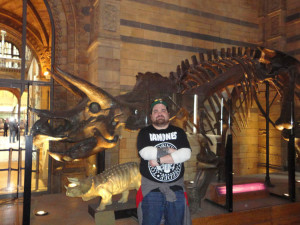Note: This is a special column from a London Study Abroad student.
By: Brian Lundergren
London, a country rooted in history, has been my home for the last six weeks; along the way, I have visited many museums, but last week I came across my favourite one yet. The National History Museum, located on Cromwell Road in London. This museum is one of the newer museums in London having only been opened in 1881, compared to the British Museum that opened in 1759. The Natural History Museum features the history of species, the extinction of species and the history of nature. I wanted to go to this museum for two reasons, they have a great exhibit on dinosaurs and my wife (Cheryl Lundgren, a current student at DMACC) wanted me to go because she is studying to be a palaeontologist. We both have an interest in dinosaurs and the exhibit did not disappoint.
As soon I walked into the museum I saw a giant Camarasaurus that is so massive that it is hard to capture in one picture. I knew right away this museum was the place I wanted to be and headed straight for the dinosaur exhibit. As I walked into the exhibit, the first thing I noticed was the lights because they had been dimmed to give the overall feeling of extinction. The first dinosaur in the exhibit is one of my favourites, the Triceratops. I also have a tattoo of the same dinosaur and made sure to get my picture taken next to the prehistoric giant. The dinosaur bones on display are so massive in size that they created an elevated walkway for better overall viewing.
The purpose of the dinosaur exhibit is to educate the public about the history of dinosaurs and how they lived while on earth. One display that stood out to me was a piece of land that had dinosaur tracks small and big. The tracks represented the prey and the hunter; the smaller tracks were the prey and the larger tracks where right behind them in a chase sequence. Close to the end of the exhibit was a huge robotic Tyrannosaurus Rex that looked like something straight out of the film Jurassic Park. The end of the exhibit talks about the theories surrounding the extinction of dinosaurs and the history of early palaeontology that discovered some of the first bones. This exhibit was well worth the trip and my favourite so far.
The exhibit called Treasures featured items that are thousands of years old and very rare. This exhibit was equally as impressive and I am glad to be able to say that I have personally seen these very old objects. The Broken Hill Skull is the first early human fossil found in Africa. Identified as the species Homo heidelbergernsis; it is said to be the most likely ancestor to modern humans.






Comments